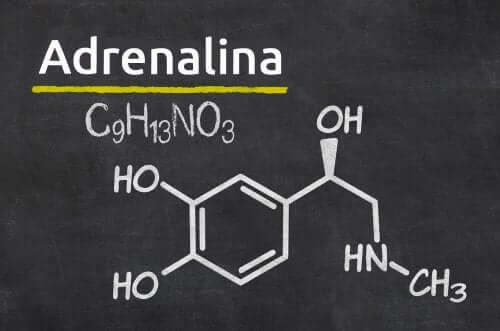Epinephrine: When and How to Administer It

Epinephrine, better known as adrenaline, is a hormone and neurotransmitter used in emergencies when the patient is suffering from cardiac arrest. This drug has historically been used to treat bronchospasms and hypoglycemia. However, today there are other more specific drugs in existence to treat these conditions.
Adrenaline is a substance that increases heart rate, constricts blood vessels, dilates the airways, and participates in the fight or flight reaction of the nervous system in an emergency. To get a little more technical, adrenaline is a catecholamine. It’s a monoamine synthesized in the adrenal glands and the precursors of this substance are phenylalanine and tyrosine.
You might like: Allergy Tests: Types and Procedures
How is epinephrine administered?

- Intramuscular (IM)
- Subcutaneous
- Intravenous (IV)
- Intracardiac: only in cases of extreme severity, and if the intravenous route is not practicable.
The last two types of administration must be carried out in the hospital, under cardiac monitoring. Additionally, the epinephrine solution must be diluted with one of the following substances before injection:
- 0.9% sodium chloride solution
- 5% glucose
- 5% glucose in 0.9% sodium chloride solution.
Also, to prevent the drug from becoming inactive due to light or oxidation, it is a good idea to use the product right after diluting it.
Regarding the dosage and the method of administration, both parameters will depend on the diagnosis and the condition of the patient. However, in an emergency, the fastest method of administration is necessary (for example, via IV or an intravenous solution).
Uses of epinephrine

Heart attack
In addition to cardiac arrest, adrenaline is also useful for treating other heart problems, such as arrhythmias that result from a decreased or absent cardiac output.
The purpose of administering epinephrine is to cause vasoconstriction and increase cardiac output. In other words, it contracts the heart and increases your heart rate to “revive it.”
You might like: Learn the Symptoms of a Cardiac Arrest
Anaphylaxis
Epinephrine is also a first-line treatment for anaphylaxis. The condition of anaphylaxis can develop due to a severe allergic reaction and can even lead to death in the event of extreme bronchoconstriction. In these cases, medical professionals will administer this drug since it’s able to dilate the respiratory tract and allow the patient to breathe.
Joint administration with local anesthetics
Epinephrine is added to a variety of local anesthetics administered as injectables. The reason for this combination is that the vasoconstrictive effects of adrenaline make it possible to delay absorption and thus prolong the effect of the anesthetic drug.
That being said, however, some of the side effects of using local anesthetics with epinephrine may be due to the effects of the epinephrine and can include:
- Apprehension/uneasiness
- Tachycardia
- Tremors
Possible side effects of epinephrine
Using this substance can have possible side effects and complications, especially when administered intravenously and intracardially. Possible adverse reactions to epinephrine include:
- Palpitations and tremors.
- Tachycardia.
- Cardiac arrhythmias.
- Anxiety and hypertension.
- Headaches.
- Acute pulmonary edema.
Also, there are several contraindications for epinephrine. In these conditions, epinephrine is not an appropriate medication. For example, for patients being treated with non-selective beta-blocker drugs, epinephrine is not an appropriate medication. This is because it can lead to a very dangerous drug interaction, which can cause severe hypertension and even cerebral hemorrhage.
Although many people believe that the administration of epinephrine can cause heart failure due to its strong vasoconstrictor effect, this is not true. The coronary arteries have only one type of receptor that triggers vasodilation, not vasoconstriction, when in contact with adrenaline.
Conclusion
Epinephrine, or adrenaline, is a drug that administered through different channels depending on the patient’s condition and situation. Additionally, it’s a valuable treatment for cardiac arrest and anaphylactic reactions.
There are types of epinephrine you can self-inject if you are at risk for suffering from anaphylactic shock.
Like all medicines, it is not free of side effects, which you should take into account when administering this medication.
All cited sources were thoroughly reviewed by our team to ensure their quality, reliability, currency, and validity. The bibliography of this article was considered reliable and of academic or scientific accuracy.
- Luis Navarro J. C. (2000). Adrenalina (Epinefrina). Revista de Emergencias y Catástrofes.
- Cardona Dahl, V. (2010). Guía de actuación en anafilaxia. Medicina Clínica. https://doi.org/10.1016/j.medcli.2010.10.003
- Ateneo, E. El. (2006). Drogas vasoactivas en el paciente critico. Medicina Intensiva.
This text is provided for informational purposes only and does not replace consultation with a professional. If in doubt, consult your specialist.









